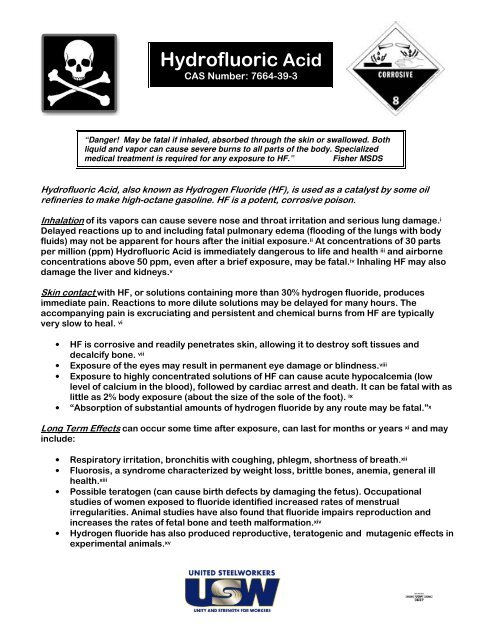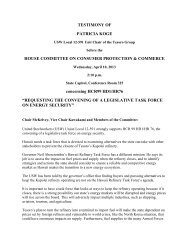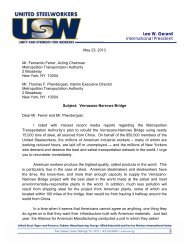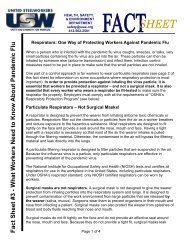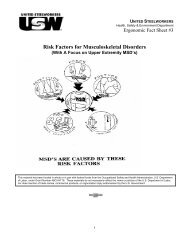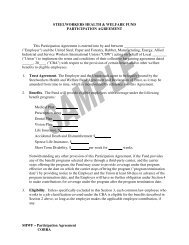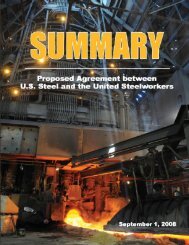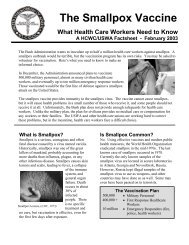Hydrofluoric Acid
Hydrofluoric Acid
Hydrofluoric Acid
You also want an ePaper? Increase the reach of your titles
YUMPU automatically turns print PDFs into web optimized ePapers that Google loves.
<strong>Hydrofluoric</strong> <strong>Acid</strong><br />
CAS Number: 7664-39-3<br />
“Danger! May be fatal if inhaled, absorbed through the skin or swallowed. Both<br />
liquid and vapor can cause severe burns to all parts of the body. Specialized<br />
medical treatment is required for any exposure to HF.” Fisher MSDS<br />
<strong>Hydrofluoric</strong> <strong>Acid</strong>, also known as Hydrogen Fluoride (HF), is used as a catalyst by some oil<br />
refineries to make high-octane gasoline. HF is a potent, corrosive poison.<br />
Inhalation of its vapors can cause severe nose and throat irritation and serious lung damage. i<br />
Delayed reactions up to and including fatal pulmonary edema (flooding of the lungs with body<br />
fluids) may not be apparent for hours after the initial exposure. ii At concentrations of 30 parts<br />
per million (ppm) <strong>Hydrofluoric</strong> <strong>Acid</strong> is immediately dangerous to life and health iii and airborne<br />
concentrations above 50 ppm, even after a brief exposure, may be fatal. iv Inhaling HF may also<br />
damage the liver and kidneys. v<br />
Skin contact with HF, or solutions containing more than 30% hydrogen fluoride, produces<br />
immediate pain. Reactions to more dilute solutions may be delayed for many hours. The<br />
accompanying pain is excruciating and persistent and chemical burns from HF are typically<br />
very slow to heal. vi<br />
• HF is corrosive and readily penetrates skin, allowing it to destroy soft tissues and<br />
decalcify bone. vii<br />
• Exposure of the eyes may result in permanent eye damage or blindness. viii<br />
• Exposure to highly concentrated solutions of HF can cause acute hypocalcemia (low<br />
level of calcium in the blood), followed by cardiac arrest and death. It can be fatal with as<br />
little as 2% body exposure (about the size of the sole of the foot). ix<br />
• “Absorption of substantial amounts of hydrogen fluoride by any route may be fatal.” x<br />
Long Term Effects can occur some time after exposure, can last for months or years xi and may<br />
include:<br />
• Respiratory irritation, bronchitis with coughing, phlegm, shortness of breath. xii<br />
• Fluorosis, a syndrome characterized by weight loss, brittle bones, anemia, general ill<br />
health. xiii<br />
• Possible teratogen (can cause birth defects by damaging the fetus). Occupational<br />
studies of women exposed to fluoride identified increased rates of menstrual<br />
irregularities. Animal studies have also found that fluoride impairs reproduction and<br />
increases the rates of fetal bone and teeth malformation. xiv<br />
• Hydrogen fluoride has also produced reproductive, teratogenic and mutagenic effects in<br />
experimental animals. xv
<strong>Hydrofluoric</strong> <strong>Acid</strong><br />
A<br />
(HF) releases can be dangerous beyond the refinery fence line<br />
Due to the physical nature of HF (boiling point is 67° F), a release of it in an environment not<br />
substantially cooler than its boiling point is likely to form a vapor cloud. Unfortunately<br />
incidences involving HF are all too common. Recent examples include:<br />
• March 11, 2009 – 13 workers were sent to the hospital after a 22 pound release of<br />
hydrofluoric acid at the Sunoco refinery in South Philadelphia, Pa. xvi<br />
• March 22, 2009 - 5000 residents were evacuated for over 12 hours after a truck carrying<br />
33,000 lbs. of hydrofluoric acid overturned in the small town of Wind Gap, Pa., causing a<br />
small spill. xvii<br />
• July 19, 2009 – a 34 year-old worker was critically injured during a fire and release of<br />
hydrofluoric acid at the CITGO refinery in Corpus Christi, Texas. xviii<br />
• August 6, 2009 – 2 workers were injured, one critically, during a leak of propane and<br />
hydrofluoric acid at the Exxon Mobil’s refinery in Joliet, Ill. xix<br />
While some 200,000 000 chemicals are now commonly used in commerce, xx the dangers posed by<br />
HF are well recognized:<br />
• HF is one of 77 toxic chemicals covered under the EPA’s Risk Management Program. xxi<br />
• HF is one of 137 “highly hazardous chemicals” covered under OSHA’s Process Safety<br />
Management Program. xxii<br />
• HF is one of approximately 360 “Extremely Hazardous Substances” covered under<br />
Emergency Planning and Community Right-To-Know Act, Section 302. xxiii<br />
• HF is one of fewer than 200 Hazardous Air Pollutants covered under the Clean Air Act. xxiv<br />
• The legal workplace exposure limit (OSHA PEL) is 3 ppm averaged over 8 hours. xxv<br />
• The American Conference of Governmental Industrial Hygienists (ACGIH) threshold limit<br />
value (TLV) is 0.5 ppm (averaged over 10 hour work shift) and 2 ppm not to be exceeded<br />
at any time during the work shift xxvi<br />
i Massachusetts Toxics Use Reduction Institute, Chemical Fact Sheet on <strong>Hydrofluoric</strong> <strong>Acid</strong><br />
ii Environment, Health and Safety Information for the Berkeley Campus Fact Sheet on <strong>Hydrofluoric</strong> <strong>Acid</strong> 6/19/08<br />
http://www.ehs.berkeley.edu/pubs/factsheets/40hf.pdf<br />
iii Centers for Disease Control, National Institute of Occupational Health, NIOSH Pocket Guide to Chemical Hazards<br />
http://www.cdc.gov/niosh/npg/npgd0334.html<br />
iv Environment, Health and Safety Information for the Berkeley Campus Fact Sheet on <strong>Hydrofluoric</strong> <strong>Acid</strong> 6/19/08<br />
http://www.ehs.berkeley.edu/pubs/factsheets/40hf.pdf<br />
v Massachusetts Toxics Use Reduction Institute, Massachusetts Chemical Fact Sheet on <strong>Hydrofluoric</strong> <strong>Acid</strong><br />
vi ibid<br />
vii Environment, Health and Safety Information for the Berkeley Campus Fact Sheet on <strong>Hydrofluoric</strong> <strong>Acid</strong> 6/19/08<br />
http://www.ehs.berkeley.edu/pubs/factsheets/40hf.pdf<br />
viii ibid<br />
ix Indiana University Chemical Fact Sheet on <strong>Hydrofluoric</strong> <strong>Acid</strong> www.ehs.Indiana.edu<br />
x ATSDR, “Hydrogen Fluoride.”<br />
xi NJ Dept of Health Right to Know Hazardous Substance Fact Sheet on Hydrogen Fluoride, April 2009<br />
xii ibid<br />
xiii Environment, Health and Safety Information for the Berkeley Campus Fact Sheet on <strong>Hydrofluoric</strong> <strong>Acid</strong> 6/19/08<br />
http://www.ehs.berkeley.edu/pubs/factsheets/40hf.pdf<br />
xiv Indiana University Chemical Fact Sheet on <strong>Hydrofluoric</strong> <strong>Acid</strong> www.ehs.Indiana.edu<br />
xv US Dept of Labor, OSHA, Occupational Safety and Health Guideline for Hydrogen Fluoride www.osha.gov<br />
xvi Andrew Maykuth, “Deadly acid poses a safety issue for Sunoco.” Philadelphia Inquirer. Sept. 23, 2009.<br />
http://www.philly.com/philly/business/60551327.html Sept. 23, 2009.<br />
xvii Timesleader.com, “Hazardous material prompts Pa. evacuation order.” Mar 23, 2009. http://www.timesleader.com/news/ap?articleID=1870287 Oct. 9,<br />
2009.<br />
xviii Denise Malan, “Citgo defends its plan to restart fire-damaged unit.” Caller.com, Corpus Christie, Texas. Oct 2, 2009. www.caller.com, Oct. 5, 2009.<br />
xix Nick Snow, “HF release at Joliet refinery investigated.” Oil & Gas Journal. Aug. 11, 2009. www.ogj.com Oct 9, 2009.<br />
xx Chemical Abstract Service http://www.cas.org/cgi-bin/cas/regreport.pl<br />
xxi USEPA List of Lists Consolidated List of Chemicals Subject to the Emergency Planning and Community Right-To-Know Act (EPCRA) and Section 112 ®<br />
of the Clean Air Act http://www.epa.gov/osweroe1/docs/chem/title3_Oct_2006.pdf#lol<br />
xxii US DOL, OSHA, List of Highly Hazardous Chemicals, Toxics and Reactives 29CFR 1910.119 Appendix A http://www.osha.gov<br />
xxiii USEPA List of Lists Consolidated List of Chemicals Subject to the Emergency Planning and Community Right-To-Know Act (EPCRA) and Section 112 ®<br />
of the Clean Air Act http://www.epa.gov/osweroe1/docs/chem/title3_Oct_2006.pdf#lol<br />
xxiv USEPA The Clean Air Act Amendments of 1990 List of Hazardous Air Pollutants http://www.epa.gov/ttn/atw/orig189.html<br />
xxv NJ Dept of Health Right to Know Hazardous Substance Fact Sheet on Hydrogen Fluoride, April 2009<br />
xxvi ibid.


